Photovoltaic Thermal Collectors Integrated with Phase Change Materials: A Comprehensive Analysis
Abstract
:1. Introduction
2. PVT/PCM Hybrid Systems
2.1. Air-Based Hybrid PVT/PCM System
2.2. Water-Based Hybrid PVT/PCM System
3. PVT Systems with Nanofluids
4. PV Modules Integrated with PCMs
5. PV Modules Integrated with a Phase-Change Material and Fins
6. Phase-Change Material/Concentrated PV System
7. Building-Integrated PVs (BIPVs) Using PCMs
8. Conclusions and Future Scope
Author Contributions
Funding
Acknowledgments
Conflicts of Interest
References
- Ahmed, O.K.; Hamada, K.I.; Salih, A.M. Enhancement of the performance of Photovoltaic/Trombe wall system using the porous medium: Experimental and theoretical study. Energy 2019, 171, 14–26. [Google Scholar] [CrossRef]
- Ahmed, O.K.; Mohammed, Z.A. Influence of porous media on the performance of hybrid PV/Thermal collector. Renew. Energy 2017, 112, 378–387. [Google Scholar] [CrossRef]
- Ahmed, O.K.; Daoud, R.W.; Bawa, S.M.; Ahmed, A.H. Optimization of PV/T Solar Water Collector based on Fuzzy Logic Control. Int. J. Renew. Energy Dev. 2020, 9, 303–310. [Google Scholar] [CrossRef]
- Ahmed, O.K. A numerical and experimental investigation for a triangular storage collector. Sol. Energy 2018, 171, 884–892. [Google Scholar] [CrossRef]
- Ahmed, O.K.; Hamada, K.I.; Salih, A.M. Performance analysis of PV/Trombe with water and air heating system: An experimental and theoretical study. Energy Sour. Part A Recovery Util. Environ. Eff. 2019, 1–21. [Google Scholar] [CrossRef]
- Ali, M.M.; Ahmed, O.K.; Abbas, E.F. Performance of solar pond integrated with photovoltaic/thermal collectors. Energy Rep. 2020, 6, 3200–3211. [Google Scholar] [CrossRef]
- Ahmed, O.K.; Mohammed, Z.A. Dust effect on the performance of the hybrid PV/Thermal collector. Therm. Sci. Eng. Prog. 2017, 3, 114–122. [Google Scholar] [CrossRef]
- Lebbi, M.; Touafek, K.; Benchatti, A.; Boutina, L.; Khelifa, A.; Baissi, M.T.; Hassani, S. Energy performance improvement of a new hybrid PV/T Bi-fluid system using active cooling and self-cleaning: Experimental study. Appl. Therm. Eng. 2020, 182, 116033. [Google Scholar] [CrossRef]
- Abed, A.A.; Ahmed, O.K.; Weis, M.M. Performance analysis of a bi-fluid photovoltaic/trombe wall under Iraqi climate. AIP Conf. Proc. 2020, 2213, 020151. [Google Scholar]
- Teo, H.; Lee, P.; Hawlader, M. An active cooling system for photovoltaic modules. Appl. Energy 2012, 90, 309–315. [Google Scholar] [CrossRef]
- Ahmed, O.K.; Bawa, S.M. Reflective mirrors effect on the performance of the hybrid PV/thermal water collector. Energy Sustain. Dev. 2018, 43, 235–246. [Google Scholar] [CrossRef]
- Ahmed, O.K.; Hamada, K.I.; Salih, A.M.; Daoud, R. A state of the art review of PV-Trombe wall system: Design and applications. Environ. Prog. Sustain. Energy 2019, 39, e13370. [Google Scholar] [CrossRef]
- Yang, X.; Sun, L.; Yuan, Y.; Zhao, X.; Cao, X. Experimental investigation on performance comparison of PV/T-PCM system and PV/T system. Renew. Energy 2017, 119, 152–159. [Google Scholar] [CrossRef]
- Abbas, E.F.; Ahmed, O.K.; Abdulkareem, F.A. The Effect of Adding Paraffin Wax to PVT Collector on Its Efficiency: A Practical Study. Int. J. Renew. Energy Res. 2021, 11, 137–146. [Google Scholar]
- Nouira, M.; Sammouda, H. Numerical study of an inclined photovoltaic system coupled with phase change material under various operating conditions. Appl. Therm. Eng. 2018, 141, 958–975. [Google Scholar] [CrossRef]
- Hasan, A.; McCormack, S.J.; Huang, M.J.; Norton, B. Energy and Cost Saving of a Photovoltaic-Phase Change Materials (PV-PCM) System through Temperature Regulation and Performance Enhancement of Photovoltaics. Energies 2014, 7, 1318–1331. [Google Scholar] [CrossRef] [Green Version]
- Zhao, J.; Ma, T.; Li, Z.; Song, A. Year-round performance analysis of a photovoltaic panel coupled with phase change material. Appl. Energy 2019, 245, 51–64. [Google Scholar] [CrossRef]
- Ali, H.M. Recent advancements in PV cooling and efficiency enhancement integrating phase change materials based systems—A comprehensive review. Sol. Energy 2020, 197, 163–198. [Google Scholar] [CrossRef]
- Aoul, K.T.; Hassan, A.; Shah, A.H.; Riaz, H. Energy performance comparison of concentrated photovoltaic—Phase change material thermal (CPV-PCM/T) system with flat plate collector (FPC). Sol. Energy 2018, 176, 453–464. [Google Scholar] [CrossRef]
- Eisapour, M.; Eisapour, A.H.; Hosseini, M.J.; Talebizadehsardari, P. Exergy and energy analysis of wavy tubes photovoltaicthermal systems using microencapsulated PCM nano-slurry coolant fluid. Appl. Energy 2020, 266, 114849. [Google Scholar] [CrossRef]
- Ahmed, O.K.; Bawa, S.M. The combined effect of nanofluid and reflective mirrors on the performance of PV/thermal solar collector. Therm. Sci. 2019, 23, 573–587. [Google Scholar] [CrossRef]
- Abed, A.A.; Ahmed, O.K.; Weis, M.M.; Hamada, K.I. Performance augmentation of a PV/Trombe wall using Al2O3/Water nano-fluid: An experimental investigation. Renew. Energy 2020, 157, 515–529. [Google Scholar] [CrossRef]
- Ahmed, A.; Khalil, O.; Mustafa, M.; Khalil, A.; Hussein, Z. Influence of glass cover on the characteristics of PV/trombe wall with BI-fluid cooling. Case Stud. Therm. Eng. 2021, 27, 101273. [Google Scholar]
- Diwania, S.; Siddiqui, A.S.; Agrawal, S.; Kumar, R. Performance assessment of PVT-air collector with V-groove absorber: A theoretical and experimental analysis. Heat Mass Transf. 2020, 57, 665–679. [Google Scholar] [CrossRef]
- Hosseinzadeh, M.; Sardarabadi, M.; Passandideh-Fard, M. Nanofluid and phase change material integrated into a photovoltaic thermal system. In Phase Change Materials; Central West Publishing: Orange, Australia, 2019; pp. 93–127. [Google Scholar]
- Ho, C.J.; Chou, W.-L.; Lai, C.-M. Thermal and electrical performances of a water-surface floating PV integrated with double water-saturated MEPCM layers. Appl. Therm. Eng. 2016, 94, 122–132. [Google Scholar] [CrossRef]
- Ren, H.; Lin, W.; Ma, Z.; Fan, W.; Wang, X. Thermal performance evaluation of an integrated photovoltaic Thermal performance evaluation of an integrated photovoltaic thermal-phase change material system using Taguchi method. Energy Proc. 2017, 121, 118–125. [Google Scholar] [CrossRef]
- Akshayveer; Singh, A.P.; Kumar, A.; Singh, O.P. Effect of natural convection and thermal storage system on the electrical and thermal performance of a hybrid PV-T/PCM systems. Mater. Today Proc. 2021, 39, 1899–1904. [Google Scholar] [CrossRef]
- Xu, H.; Wang, N.; Zhang, C.; Qu, Z.; Karimi, F. Energy conversion performance of a PV/T-PCM system under different thermal regulation strategies. Energy Convers. Manag. 2020, 229, 113660. [Google Scholar] [CrossRef]
- Fu, Z.; Liang, X.; Li, Y.; Li, L.; Zhu, Q. Performance improvement of a PVT system using a multilayer structural heat exchanger with PCMs. Renew. Energy 2021, 169, 308–317. [Google Scholar] [CrossRef]
- Su, D.; Jia, Y.; Alva, G.; Liu, L.; Fang, G. Comparative analyses on dynamic performances of photovoltaic–thermal solar collectors integrated with phase change materials. Energy Convers. Manag. 2017, 131, 79–89. [Google Scholar] [CrossRef]
- Maiti, S.; Banerjee, S.; Vyas, K.; Patel, P.; Ghosh, P.K. Self regulation of photovoltaic module temperature in V-trough using a metal–wax composite phase change matrix. Sol. Energy 2011, 85, 1805–1816. [Google Scholar] [CrossRef]
- Duan, J. A novel heat sink for cooling concentrator photovoltaic system using PCM-porous system. Appl. Therm. Eng. 2021, 186, 116522. [Google Scholar] [CrossRef]
- Lin, W.; Ma, Z.; Wang, S.; Sohel, M.I.; Cascio, E.L. Experimental investigation and two-level model-based optimisation of a solar photovoltaic thermal collector coupled with phase change material thermal energy storage. Appl. Therm. Eng. 2020, 182, 116098. [Google Scholar] [CrossRef]
- Preet, S.; Bhushan, B.; Mahajan, T. Experimental investigation of water based photovoltaic/thermal (PV/T) system with and without phase change material (PCM). Sol. Energy 2017, 155, 1104–1120. [Google Scholar] [CrossRef]
- Zhou, Y.; Liu, X.; Zhang, G. Performance of buildings integrated with a photovoltaic–thermal collector and phase change materials. Proc. Eng. 2017, 205, 1337–1343. [Google Scholar] [CrossRef]
- Lari, M.O.; Sahin, A.Z. Effect of retrofitting a silver/water nanofluid-based photovoltaic/thermal (PV/T) system with a PCM-thermal battery for residential applications. Renew. Energy 2018, 122, 98–107. [Google Scholar] [CrossRef]
- Maatallah, T.; Zachariah, R.; Al-Amri, F.G. Exergo-economic analysis of a serpentine flow type water based photovoltaic thermal system with phase change material (PVT-PCM/water). Sol. Energy 2019, 193, 195–204. [Google Scholar] [CrossRef]
- Hedayati-Mehdiabadi, E.; Sarhaddi, F.; Sobhnamayan, F. Exergy performance evaluation of a basin-type double-slope solar still equipped with phase-change material and PV/T collector. Renew. Energy 2019, 145, 2409–2425. [Google Scholar] [CrossRef]
- Fayaz, H.; Rahim, N.; Hasanuzzaman, M.; Nasrin, R.; Rivai, A. Numerical and experimental investigation of the effect of operating conditions on performance of PVT and PVT-PCM. Renew. Energy 2019, 143, 827–841. [Google Scholar] [CrossRef]
- Al Imam, M.; Beg, R.; Rahman, M.; Khan, Z.H. Performance of PVT solar collector with compound parabolic concentrator and phase change materials. Energy Build. 2016, 113, 139–144. [Google Scholar] [CrossRef]
- Xu, H.; Zhang, C.; Wang, N.; Qu, Z.; Zhang, S. Experimental study on the performance of a solar photovoltaic/thermal system combined with phase change material. Sol. Energy 2020, 198, 202–211. [Google Scholar] [CrossRef]
- Velmurugan, K.; Karthikeyan, V.; Korukonda, T.B.; Poongavanam, P.; Nadarajan, S.; Kumarasamy, S.; Wongwuttanasatian, T.; Sandeep, D. Experimental studies on photovoltaic module temperature reduction using eutectic cold phase change material. Sol. Energy 2020, 209, 302–315. [Google Scholar] [CrossRef]
- Qasim, M.A.; Ali, H.M.; Khan, M.N.; Arshad, N.; Khaliq, D.; Ali, Z.; Janjua, M.M. The effect of using hybrid phase change materials on thermal management of photovoltaic panels—An experimental study. Sol. Energy 2020, 209, 415–423. [Google Scholar] [CrossRef]
- Touati, B.; Kerroumi, N.; Virgone, J. Solar thermal energy discharging from a multiple phase change materials storage tank. Appl. Sol. Energy 2017, 53, 185–189. [Google Scholar] [CrossRef]
- Yuan, W.; Ji, J.; Modjinou, M.; Zhou, F.; Li, Z.; Song, Z.; Huang, S.; Zhao, X. Numerical simulation and experimental validation of the solar photovoltaic/thermal system with phase change material. Appl. Energy 2018, 232, 715–727. [Google Scholar] [CrossRef]
- Browne, M.C.; Norton, B.; McCormack, S. Heat retention of a photovoltaic/thermal collector with PCM. Sol. Energy 2016, 133, 533–548. [Google Scholar] [CrossRef] [Green Version]
- Gaur, A.; Ménézo, C.; Giroux-Julien, S. Numerical studies on thermal and electrical performance of a fully wetted absorber PVT collector with PCM as a storage medium. Renew. Energy 2017, 109, 168–187. [Google Scholar] [CrossRef]
- Hachem, F.; Abdulhay, B.; Ramadan, M.; el Hage, H.; el Rab, M.G.; Khaled, M. Improving the performance of photovoltaic cells using pure and combined phase change materials—Experiments and transient energy balance. Renew. Energy 2017, 107, 567–575. [Google Scholar] [CrossRef]
- Hasan, A.; Sarwar, J.; Alnoman, H.; Abdelbaqi, S. Yearly energy performance of a photovoltaic-phase change material (PV-PCM) system in hot climate. Sol. Energy 2017, 146, 417–429. [Google Scholar] [CrossRef]
- Indartono, Y.S.; Suwono, A.; Pratama, F.Y. Improving photovoltaics performance by using yellow petroleum jelly as phase change material. Int. J. Low-Carbon Technol. 2014, 11, 333–337. [Google Scholar] [CrossRef] [Green Version]
- Kazemian, A.; Salari, A.; Hakkaki-Fard, A.; Ma, T. Numerical investigation and parametric analysis of a photovoltaic thermal system integrated with phase change material. Appl. Energy 2019, 238, 734–746. [Google Scholar] [CrossRef]
- Khanna, S.; Reddy, K.S.; Mallick, T.K. Performance analysis of tilted photovoltaic system integrated with phase change material under varying operating conditions. Energy 2017, 133, 887–899. [Google Scholar] [CrossRef]
- Simón-Allué, R.; Guedea, I.; Villén, R.; Brun, G. Experimental study of Phase Change Material influence on different models of Photovoltaic-Thermal collectors. Sol. Energy 2019, 190, 1–9. [Google Scholar] [CrossRef]
- Smith, C.; Forster, P.; Crook, R. Global analysis of photovoltaic energy output enhanced by phase change material cooling. Appl. Energy 2014, 126, 21–28. [Google Scholar] [CrossRef]
- Waqas, A.; Jie, J.; Xu, L. Thermal behavior of a PV panel integrated with PCM-filled metallic tubes: An experimental study. J. Renew. Sustain. Energy 2017, 9, 053504. [Google Scholar] [CrossRef]
- Kazemian, A.; Taheri, A.; Sardarabadi, A.; Ma, T.; Passandideh-Fard, M.; Peng, J. Energy, exergy and environmental analysis of glazed and unglazed PVT system integrated with phase change material: An experimental approach. Sol. Energy 2020, 201, 178–189. [Google Scholar] [CrossRef]
- Malvi, C.S.; Dixon-Hardy, D.W.; Crook, R. Energy balance model of combined photovoltaic solar-thermal system incorporating phase change material. Sol. Energy 2011, 85, 1440–1446. [Google Scholar] [CrossRef]
- Bigaila, E.; Athienitis, A. Modeling and simulation of a photovoltaic/thermal air collector assisting a façade integrated small scale heat pump with radiant PCM panel. Energy Build. 2017, 149, 298–309. [Google Scholar] [CrossRef]
- Lin, W.; Ma, Z. Using Taguchi-Fibonacci search method to optimize phase change materials enhanced buildings with integrated solar photovoltaic thermal collectors. Energy 2016, 106, 23–37. [Google Scholar] [CrossRef]
- Al-Waeli, A.H.A.; Sopian, K.; Chaichan, M.T.; Kazem, H.A.; Ibrahim, A.; Mat, S.; Ruslan, M.H. Evaluation of the nanofluid and nano-PCM based photovoltaic thermal (PVT) system: An experi-mental study. Energy Convers. Manag. 2017, 151, 693–708. [Google Scholar] [CrossRef]
- Naghdbishi, A.; Yazdi, M.E.; Akbari, G. Experimental investigation of the effect of multi-wall carbon nanotube—Water/glycol based nanofluids on a PVT system integrated with PCM-covered collector. Appl. Therm. Eng. 2020, 178, 115556. [Google Scholar] [CrossRef]
- Sardarabadi, M.; Passandideh-Fard, M.; Maghrebi, M.-J.; Ghazikhani, M. Experimental study of using both ZnO/ water nanofluid and phase change material (PCM) in photovoltaic thermal systems. Sol. Energy Mater. Sol. Cells 2017, 161, 62–69. [Google Scholar] [CrossRef]
- Nada, S.; El-Nagar, D.; Hussein, H. Improving the thermal regulation and efficiency enhancement of PCM-Integrated PV modules using nano particles. Energy Convers. Manag. 2018, 166, 735–743. [Google Scholar] [CrossRef]
- Qiu, Z.; Ma, X.; Zhao, X.; Li, P.; Ali, S. Experimental investigation of the energy performance of a novel Microencapsulated Phase Change Material (MPCM) slurry based PV/T system. Appl. Energy 2016, 165, 260–271. [Google Scholar] [CrossRef]
- Abdelrazik, A.S.; Saidur, R.; Al-Sulaiman, F.A. Thermal regulation and performance assessment of a hybrid photovoltaic/thermal system using different combinations of nano-enhanced phase change materials. Sol. Energy Mater. Sol. Cells 2020, 215, 110645. [Google Scholar] [CrossRef]
- Tanuwijava, A.O.; Ho, C.J.; Lai, C.-M.; Huang, C.-Y. Numerical Investigation of the Thermal Management Performance of MEPCM Modules for PV Applications. Energies 2013, 6, 3922–3936. [Google Scholar] [CrossRef] [Green Version]
- Arteconi, A.; Ciarrocchi, E.; Pan, Q.; Carducci, F.; Comodi, G.; Polonara, F.; Wang, R. Thermal energy storage coupled with PV panels for demand side management of industrial building cooling loads. Appl. Energy 2017, 185, 1984–1993. [Google Scholar] [CrossRef]
- Japs, E.; Sonnenrein, G.; Steube, J.; Vrabec, J.; Kenig, E.; Krauter, S. Technical Investigation of a Photovoltaic Module with Integrated Improved Phase Change Material. In Proceedings of the 28th European Photovoltaic Solar Energy Conference and Exhibition, Paris, France, 30 September–4 October 2013. [Google Scholar] [CrossRef]
- Gkouskos, Z.; Tsoutsos, T.; Kakouriotis, A. Integrating phase change materials to photovoltaics in a mediterranean region. In Proceedings of the 27th EU Photovoltaic Solar Energy Conference and Exhibition, Frankfurt, Germany, 24–28 September 2012; pp. 305–310. [Google Scholar]
- Hasan, A.; McCormack, S.; Huang, M.J.; Norton, B. Characterization of phase change materials for thermal control of photovoltaics using Differential Scanning Calorimetry and Temperature History Method. Energy Convers. Manag. 2014, 81, 322–329. [Google Scholar] [CrossRef]
- Brano, V.L.; Ciulla, G.; Piacentino, A.; Cardona, F. Finite difference thermal model of a latent heat storage system coupled with a photovoltaic device: Description and experimental validation. Renew. Energy 2014, 68, 181–193. [Google Scholar] [CrossRef]
- Mahamudul, H.; Rahman, M.; Metselaar, H.S.C.; Mekhilef, S.; Shezan, S.A.; Sohel, R.; Bin Abu Karim, S.; Badiuzaman, W.N.I. Temperature Regulation of Photovoltaic Module Using Phase Change Material: A Numerical Analysis and Experimental Investigation. Int. J. Photoenergy 2016, 2016, 5917028. [Google Scholar] [CrossRef]
- Stropnik, R.; Stritih, U. Increasing the efficiency of PV panel with the use of PCM. Renew. Energy 2016, 97, 671–679. [Google Scholar] [CrossRef]
- Sarwar, J.; Mccormack, S.; Huang, M.J.; Norton, B. Experimental Validation of CFD modelling for thermal regulation of Photovoltaic Panels using Phase Change Material. In Proceedings of the International Conference for Sustainable Energy Storage, Belfast, UK, 21–24 February 2011; pp. 21–24. [Google Scholar]
- Emam, M.; Ookawara, S.; Ahmed, M. Performance study and analysis of an inclined concentrated photovoltaic-phase change material system. Sol. Energy 2017, 150, 229–245. [Google Scholar] [CrossRef]
- Ceylan, I.; Gürel, A.E.; Ergün, A. The mathematical modeling of concentrated photovoltaic module temperature. Int. J. Hydrogen Energy 2017, 42, 19641–19653. [Google Scholar] [CrossRef]
- Huang, M.; Eames, P.; Norton, B. Comparison of a small-scale 3D PCM thermal control model with a validated 2D PCM thermal control model. Sol. Energy Mater. Sol. Cells 2006, 90, 1961–1972. [Google Scholar] [CrossRef]
- Savvakis, N.; Tsoutsos, T. Theoretical design and experimental evaluation of a PV+PCM system in the mediterranean climate. Energy 2020, 220, 119690. [Google Scholar] [CrossRef]
- Kumar, K.S.; Revanth, S.; Sanjeev, D.; Kumar, P.S.; Surya, P. Experimental investigation of improving the energy conversion efficiency of PV cell by integrating with PCM. Mater. Today Proc. 2020, 37, 712–716. [Google Scholar] [CrossRef]
- Savvakis, N.; Dialyna, E.; Tsoutsos, T. Investigation of the operational performance and efficiency of an alternative PV + PCM concept. Sol. Energy 2020, 211, 1283–1300. [Google Scholar] [CrossRef]
- Elsheniti, M.B.; Hemedah, M.A.; Sorour, M.; El-Maghlany, W.M. Novel enhanced conduction model for predicting performance of a PV panel cooled by PCM. Energy Convers. Manag. 2020, 205, 112456. [Google Scholar] [CrossRef]
- Rajvikram, M.; Leoponraj, S.; Ramkumar, S.; Akshaya, H.; Dheeraj, A. Experimental investigation on the abasement of operating temperature in solar photovoltaic panel using PCM and aluminium. Sol. Energy 2019, 188, 327–338. [Google Scholar]
- Nehari, T.; Benlekkam, M.; Nehari, D.; Youcefi, A. The effect of inclination on the passive cooling of the solar PV panel by using phase change material. Int. J. Renew. Energy Res. 2016, 6, 1434–1441. [Google Scholar]
- Khanna, S.; Reddy, K.S.; Mallick, T.K. Optimization of finned solar photovoltaic phase change material (finned pv pcm) system. Int. J. Therm. Sci. 2018, 130, 313–322. [Google Scholar] [CrossRef]
- Groulx, D.; Biwole, P.H.; Bhouri, M. Phase change heat transfer in a rectangular enclosure as a function of inclination and fin placement. Int. J. Therm. Sci. 2020, 151, 106260. [Google Scholar] [CrossRef]
- Yıldız, Ç.; Arıcı, M.; Nižetić, S.; Shahsavar, A. Numerical investigation of natural convection behavior of molten PCM in an enclosure having rectangular and tree-like branching fins. Energy 2020, 207, 118223. [Google Scholar] [CrossRef]
- Cui, T.; Xuan, Y.; Li, Q. Design of a novel concentrating photovoltaic–thermoelectric system incorporated with phase change materials. Energy Convers. Manag. 2016, 112, 49–60. [Google Scholar] [CrossRef]
- Cui, T.; Xuan, Y.; Yin, E.; Li, Q.; Li, D. Experimental investigation on potential of a concentrated photovoltaic-thermoelectric system with phase change materials. Energy 2017, 122, 94–102. [Google Scholar] [CrossRef]
- Hasan, A.; McCormack, S.J.; Huang, M.J.; Norton, B. Evaluation of phase change materials for thermal regulation enhancement of building integrated photovoltaics. Sol. Energy 2010, 84, 1601–1612. [Google Scholar] [CrossRef] [Green Version]
- Hasan, A.; Alnoman, H.; Rashid, Y. Impact of integrated photovoltaic-phase change material system on building energy efficiency in hot climate. Energy Build. 2016, 130, 495–505. [Google Scholar] [CrossRef]
- Huang, M.J.; Eames, P.C.; Norton, B. Thermal regulation of building-integrated photovoltaics using phase change materials. Int. J. Heat Mass Transf. 2004, 47, 2715–2733. [Google Scholar] [CrossRef]
- Huang, M.J.; Eames, P.C.; Norton, B. Phase change materials for limiting temperature rise in building integrated photo-voltaics. Sol. Energy 2006, 80, 1121–1130. [Google Scholar] [CrossRef]
- Su, D.; Jia, Y.; Lin, Y.; Fang, G. Maximizing the energy output of a photovoltaic–thermal solar collector incorporating phase change materials. Energy Build. 2017, 153, 382–391. [Google Scholar] [CrossRef]
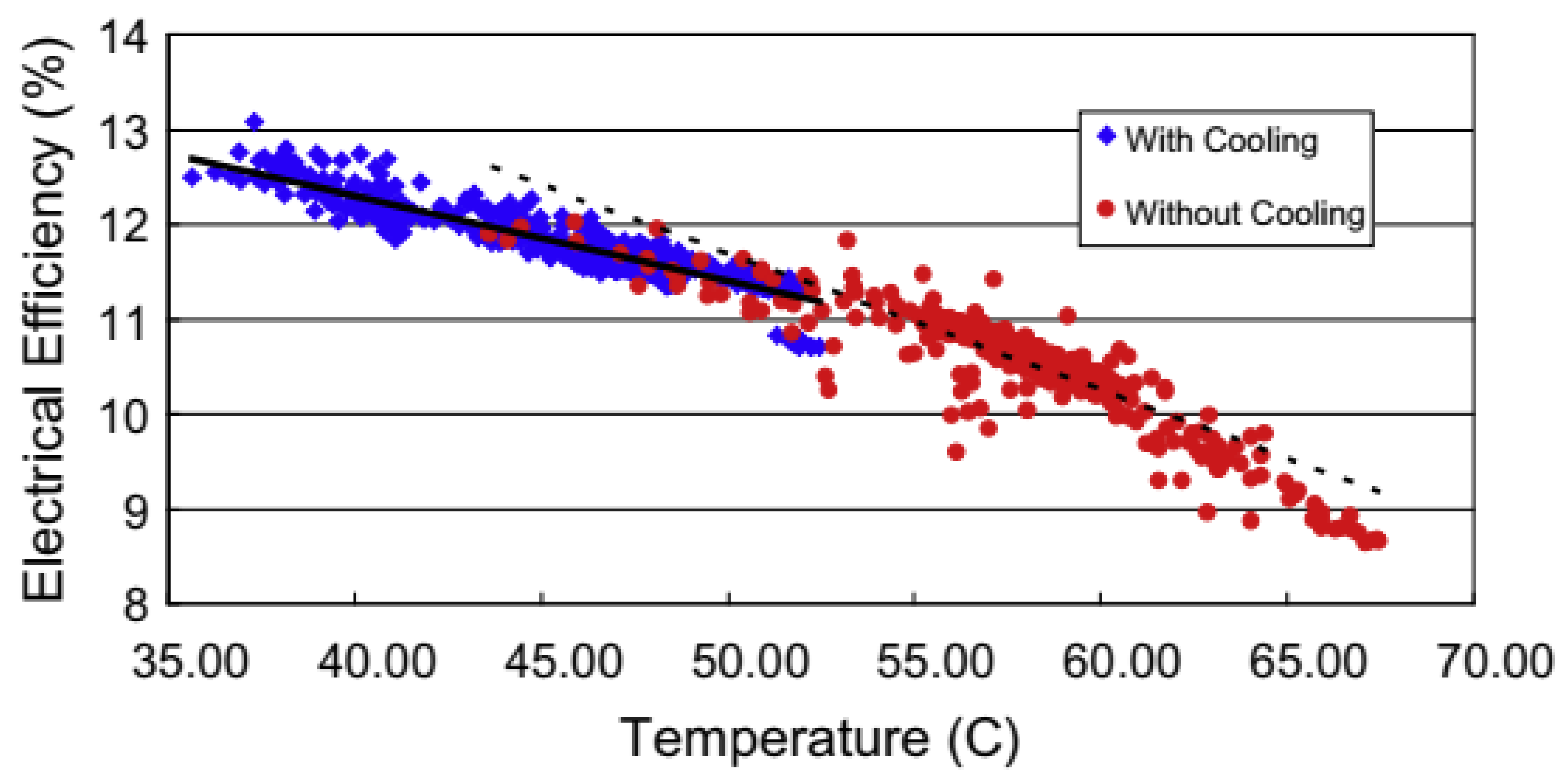
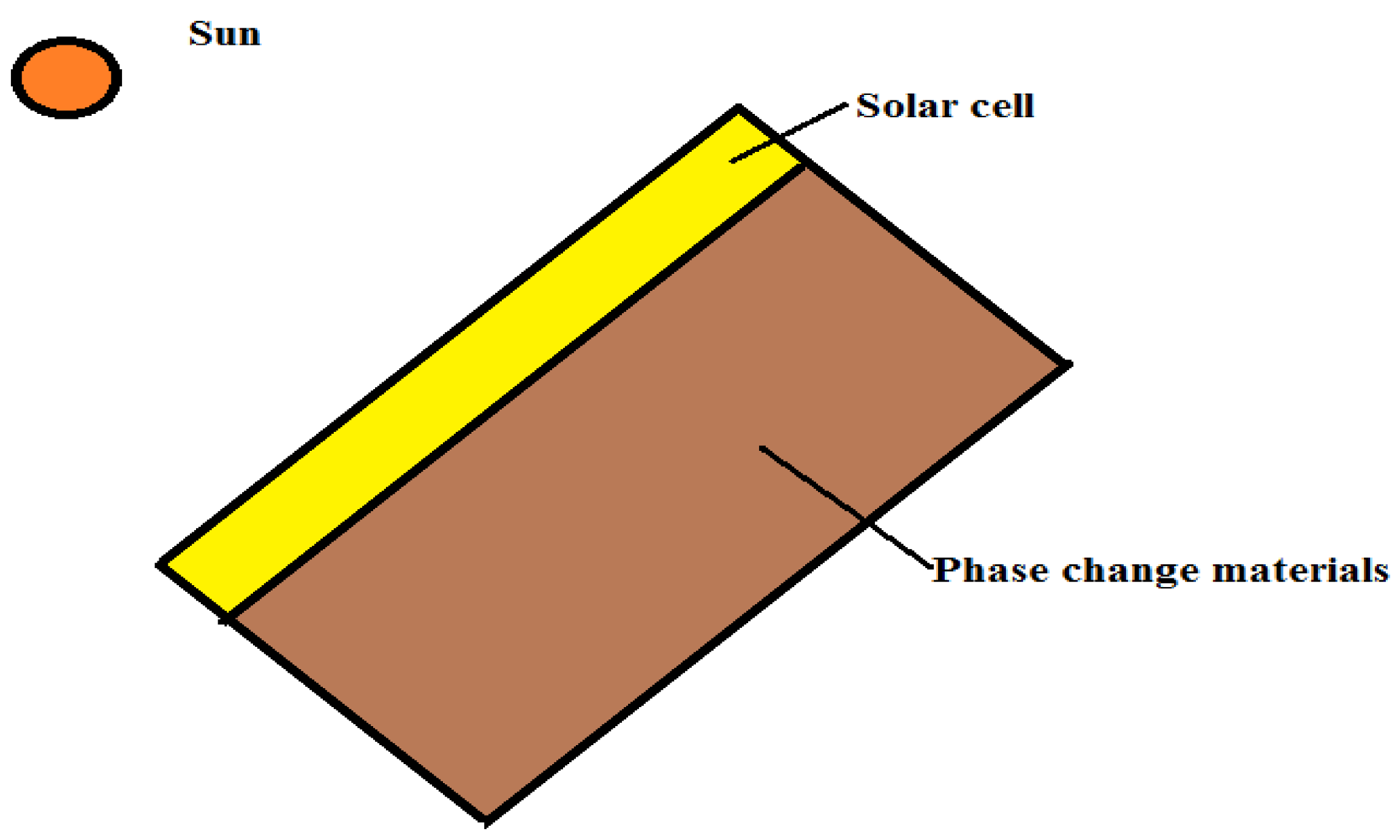

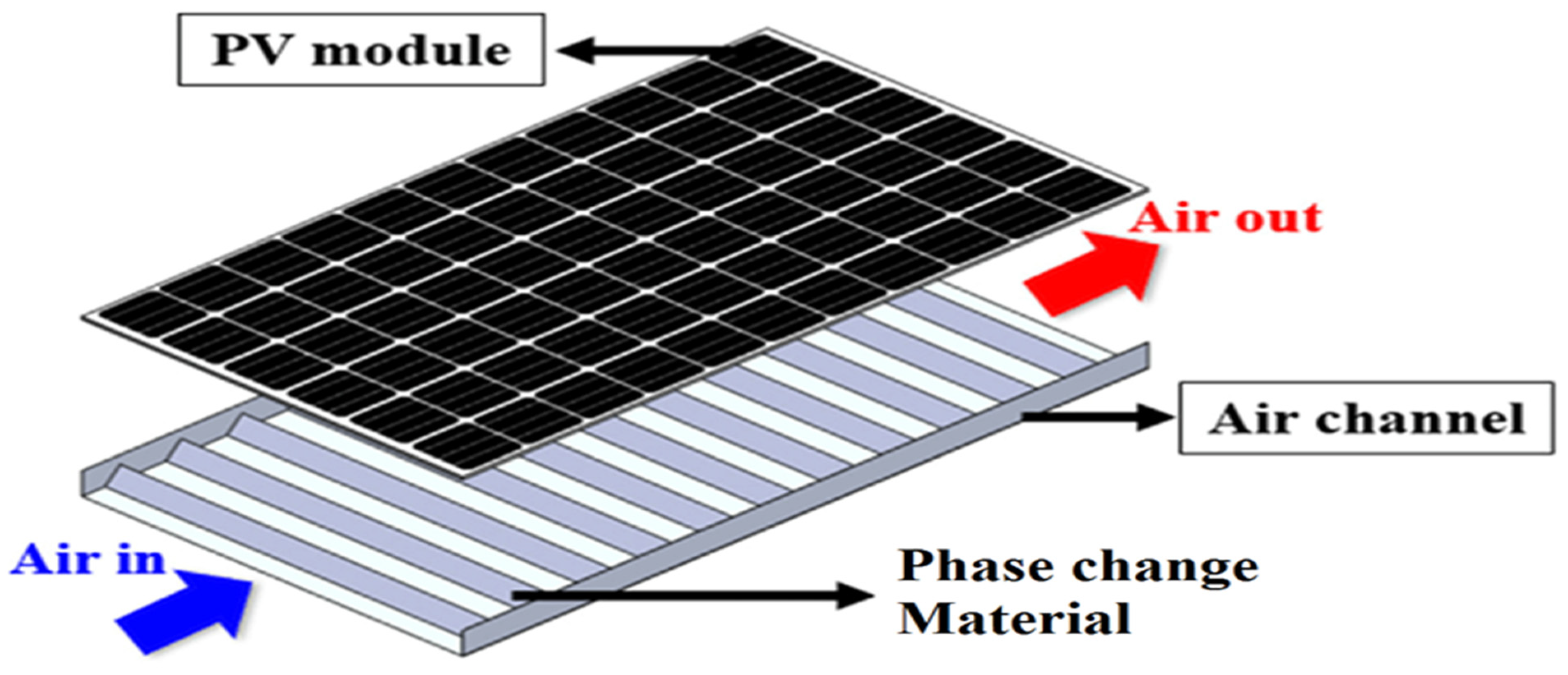
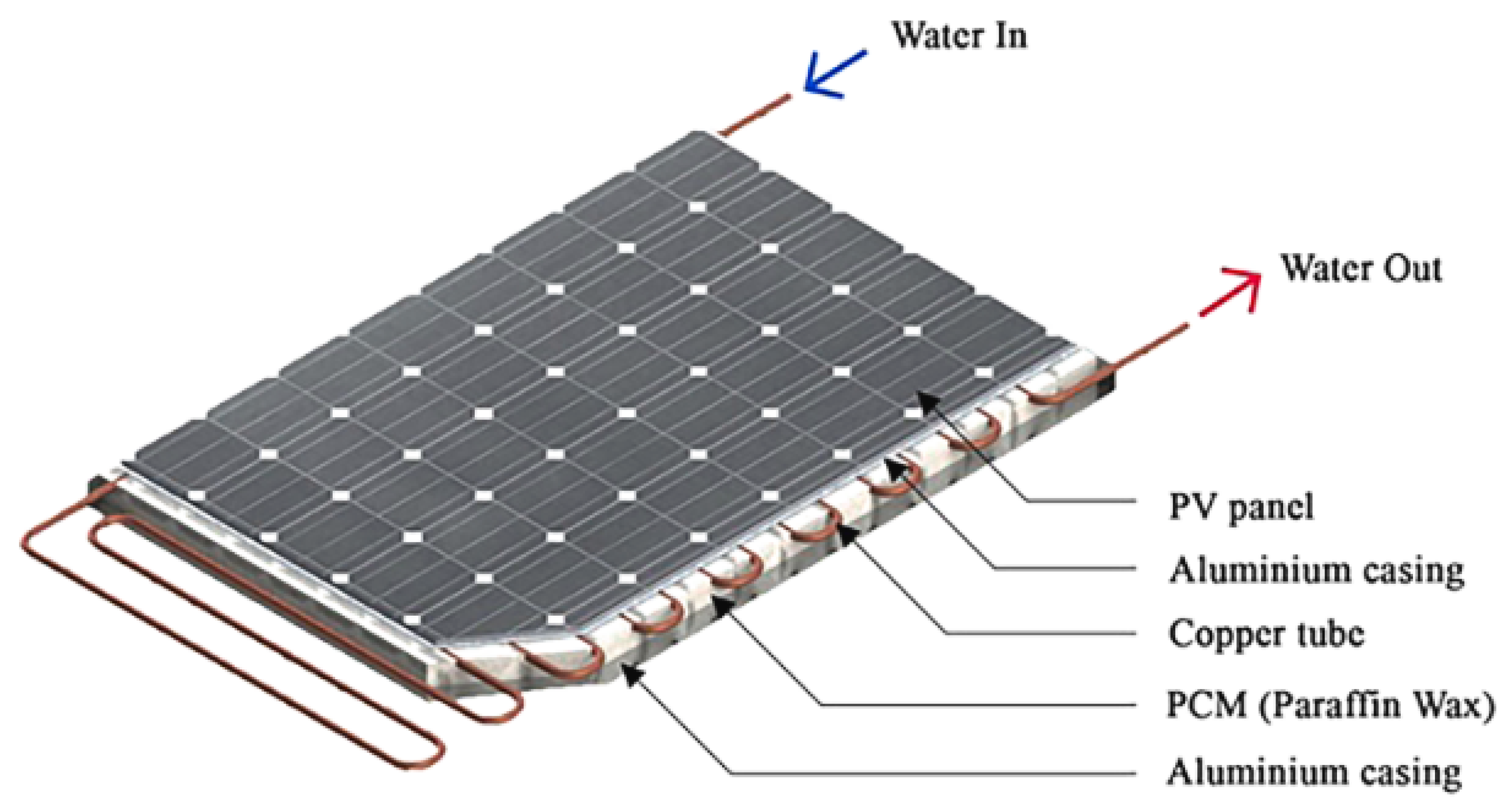

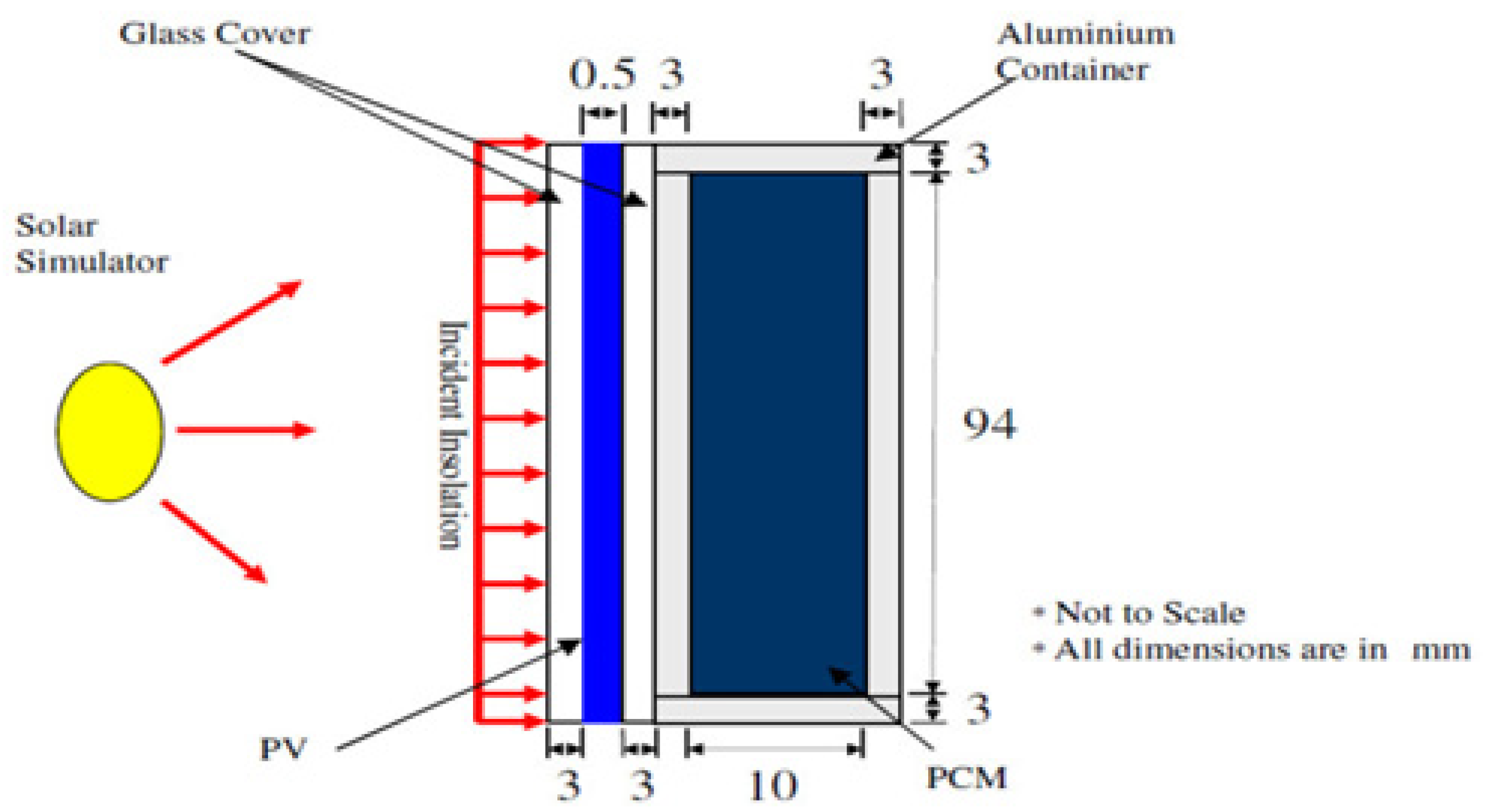

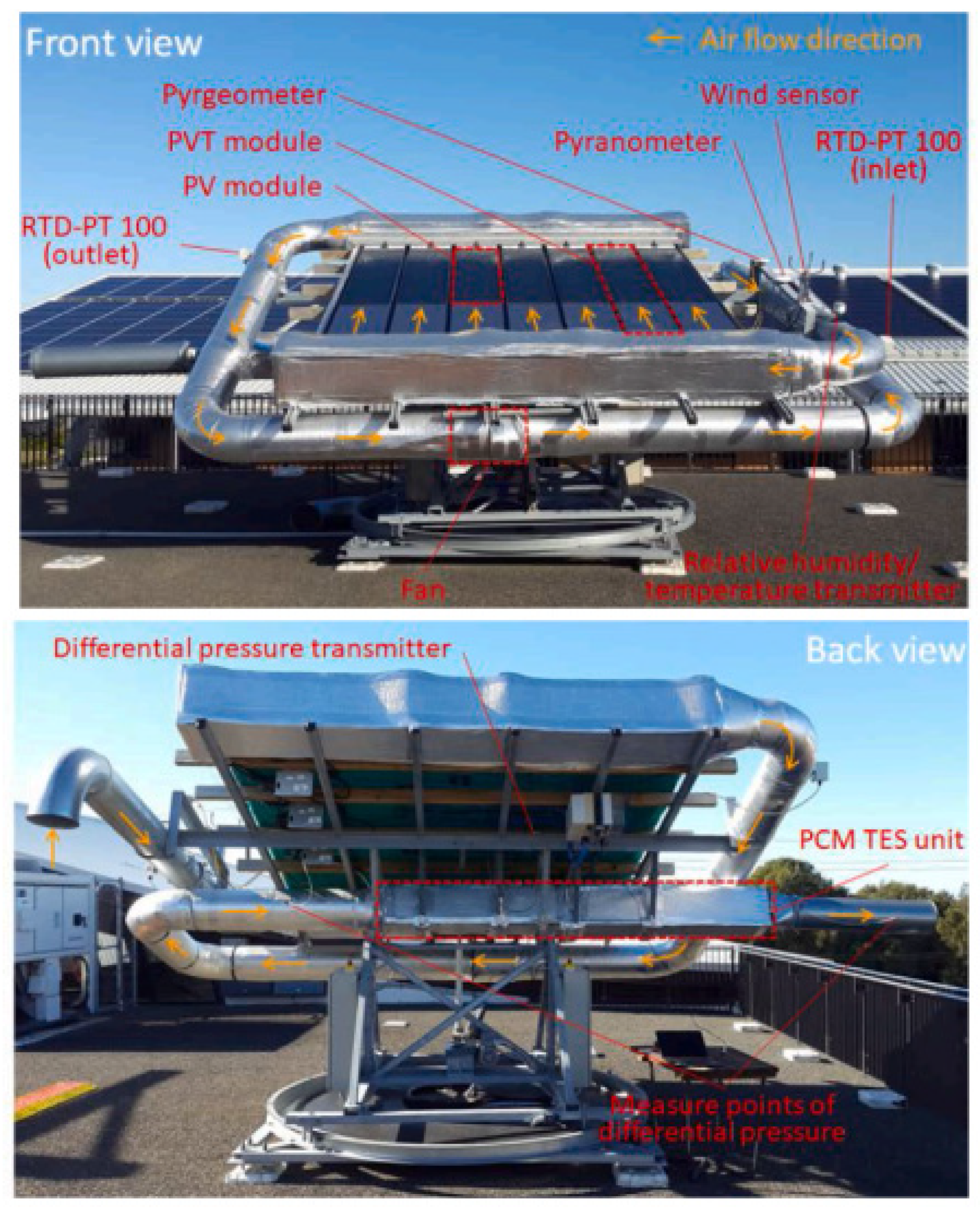
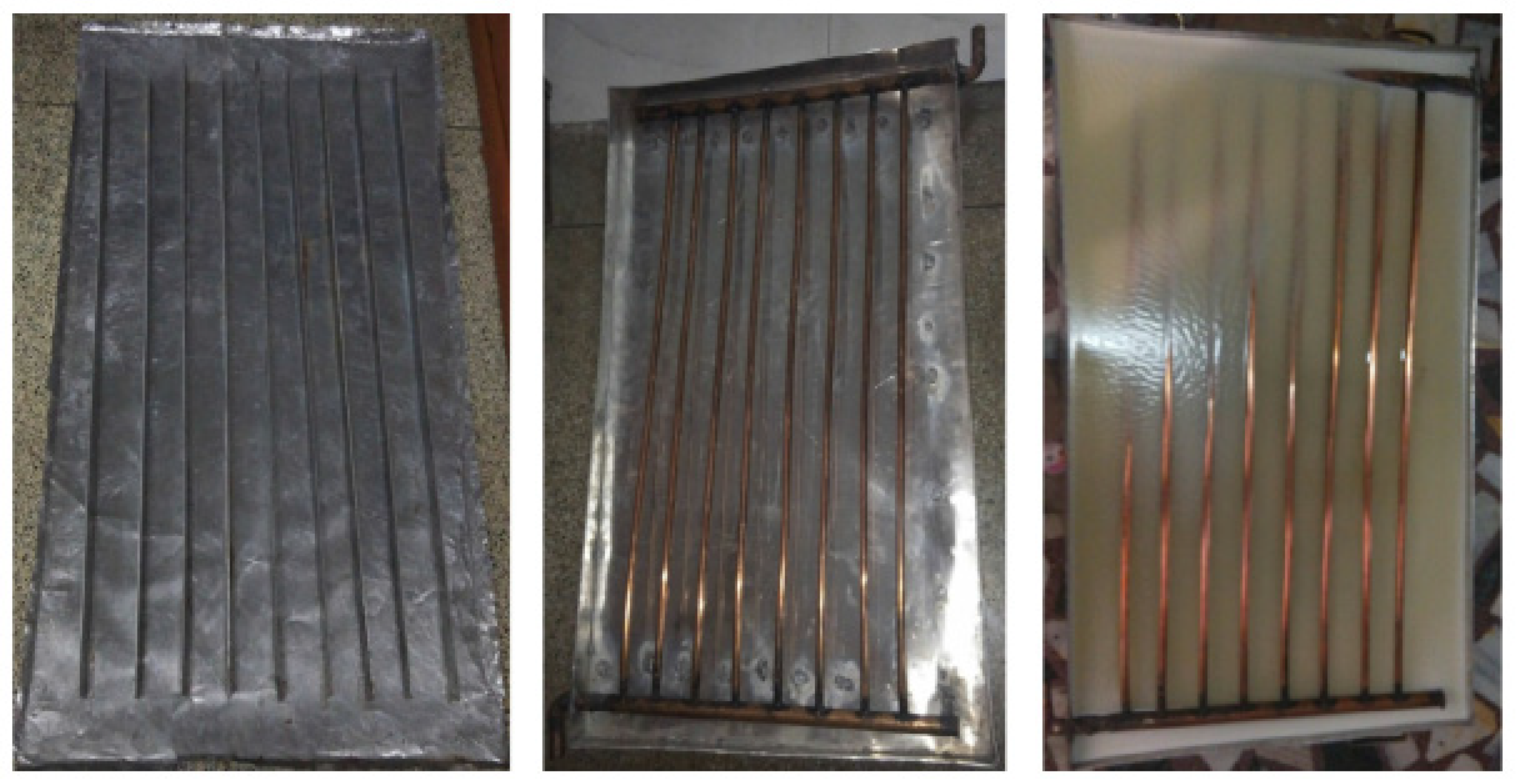
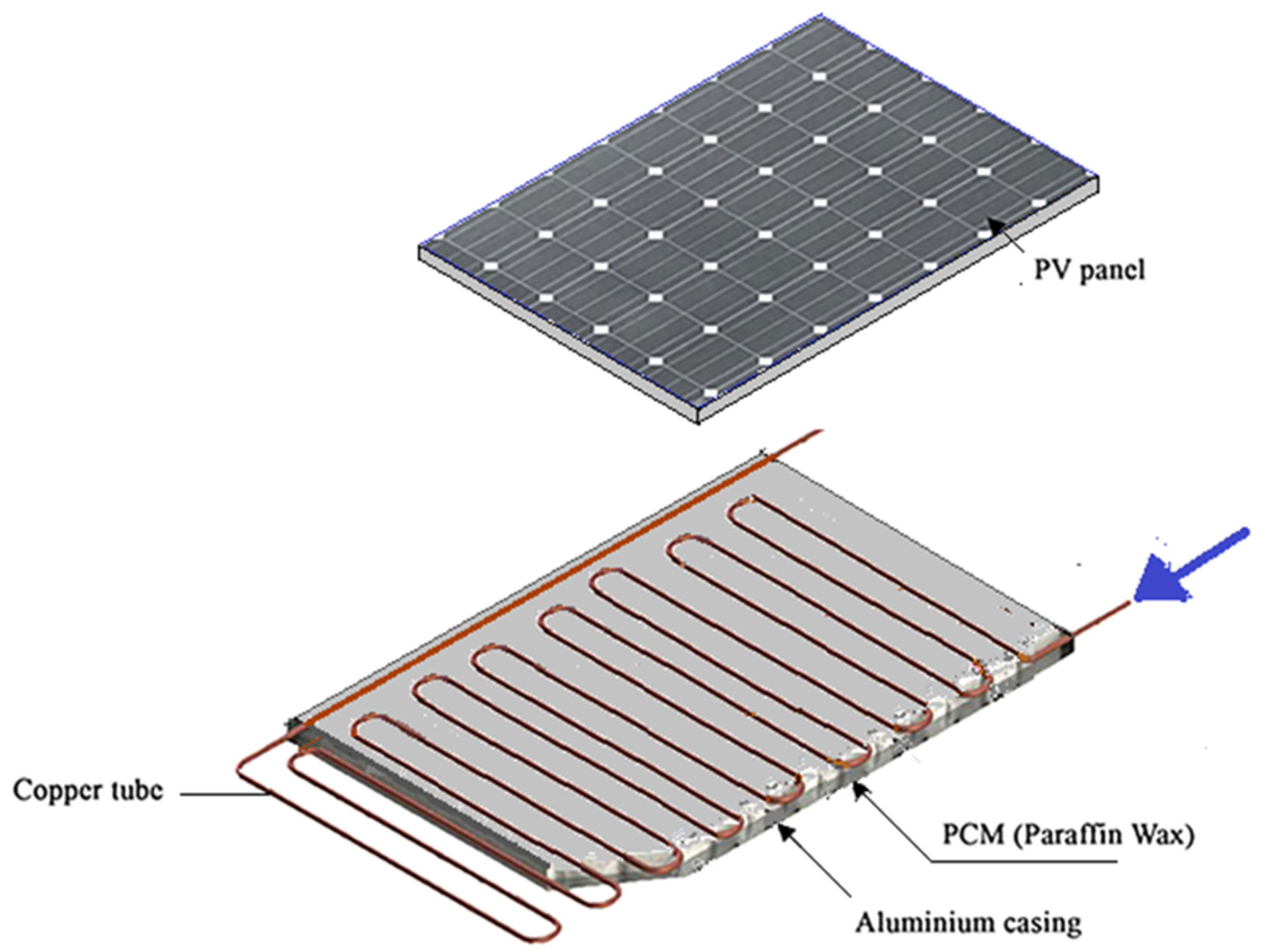

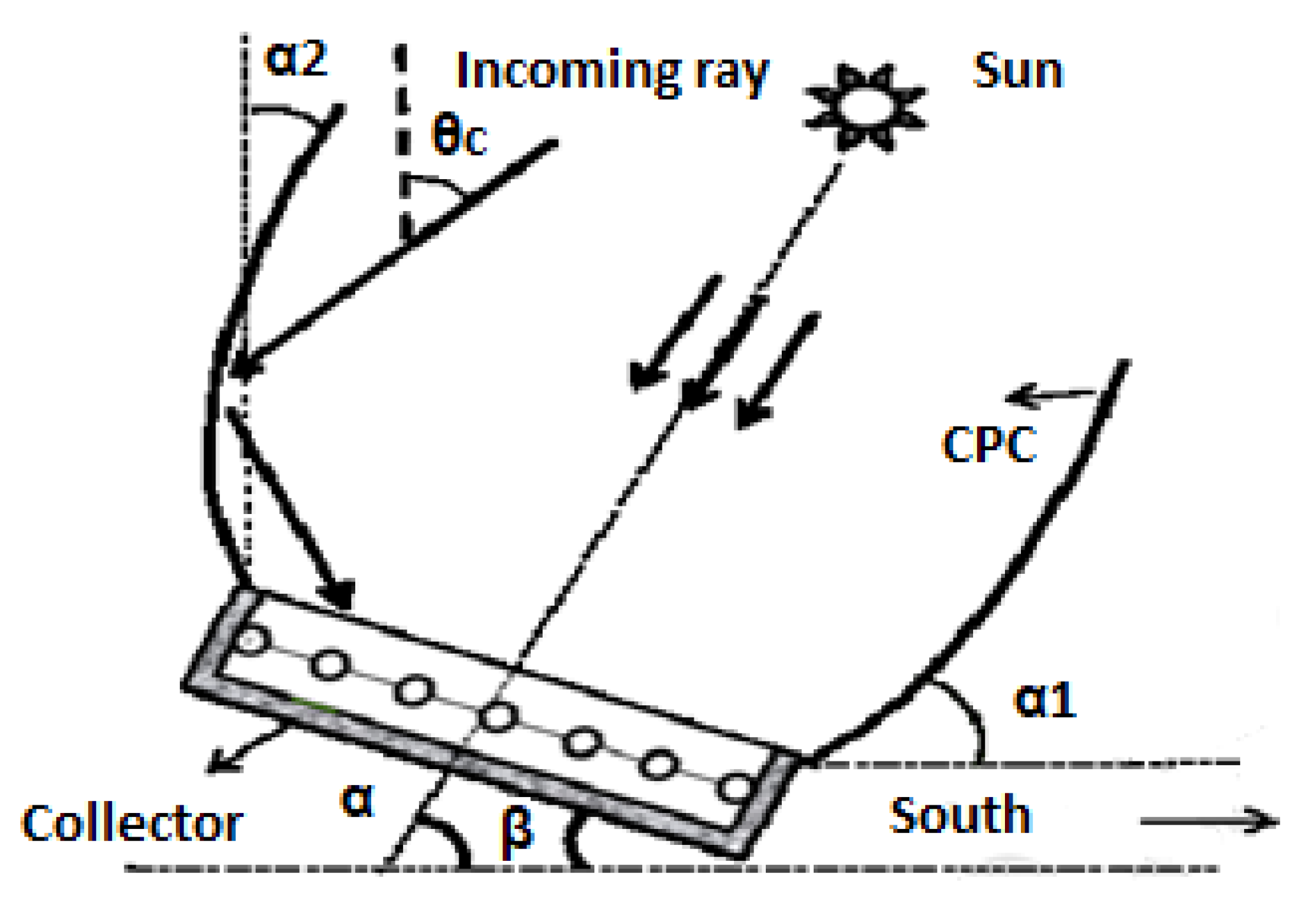


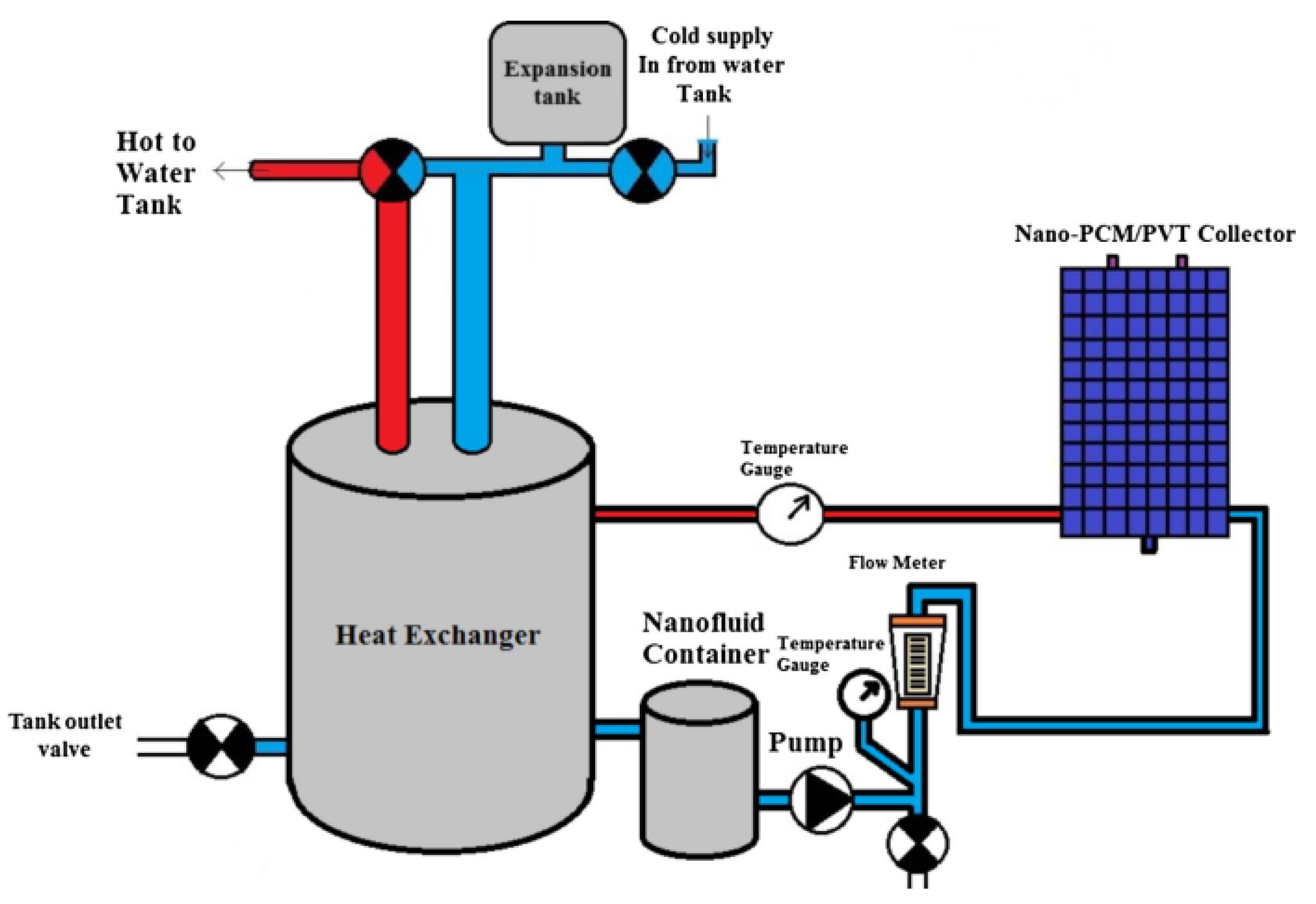
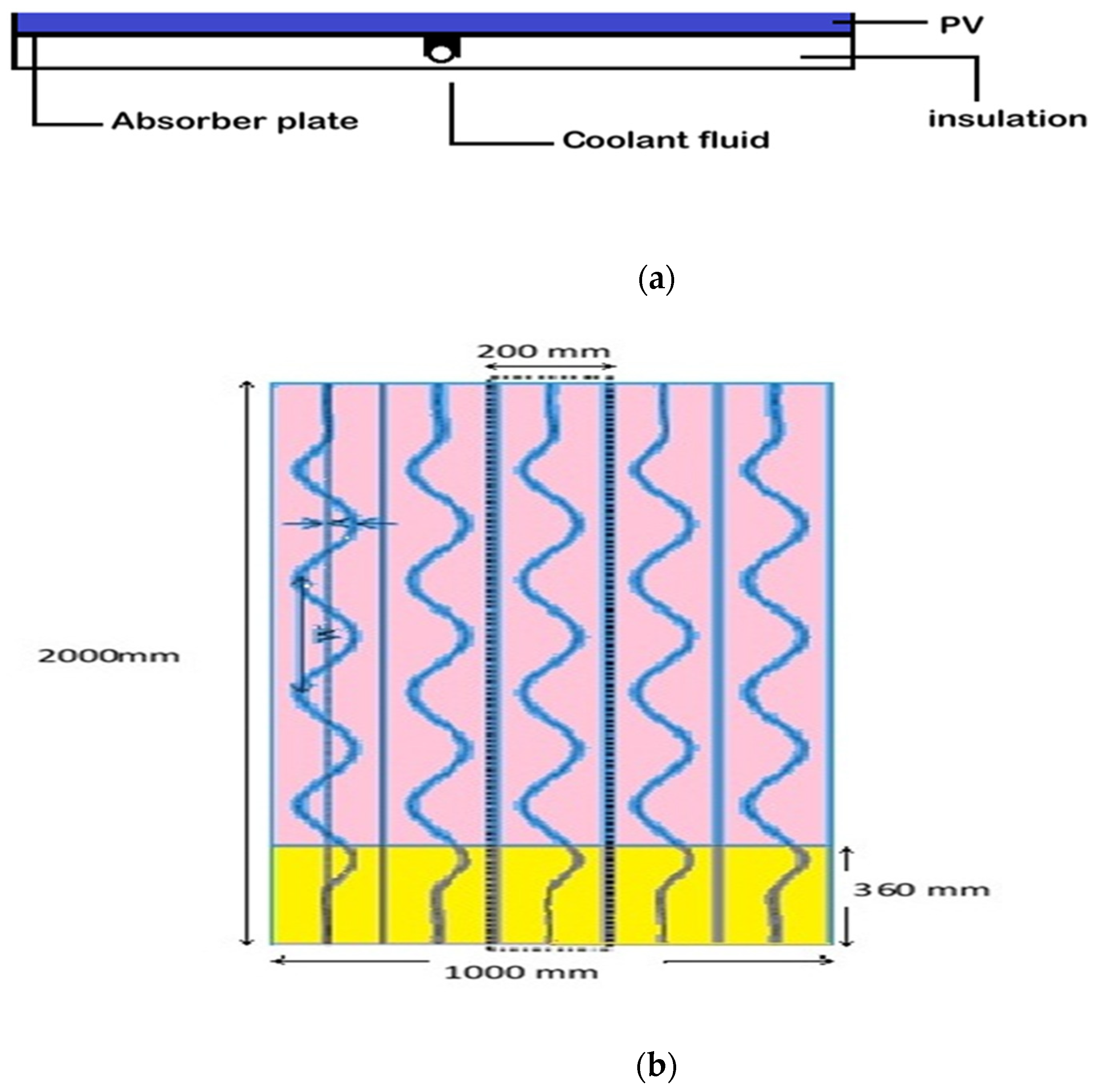
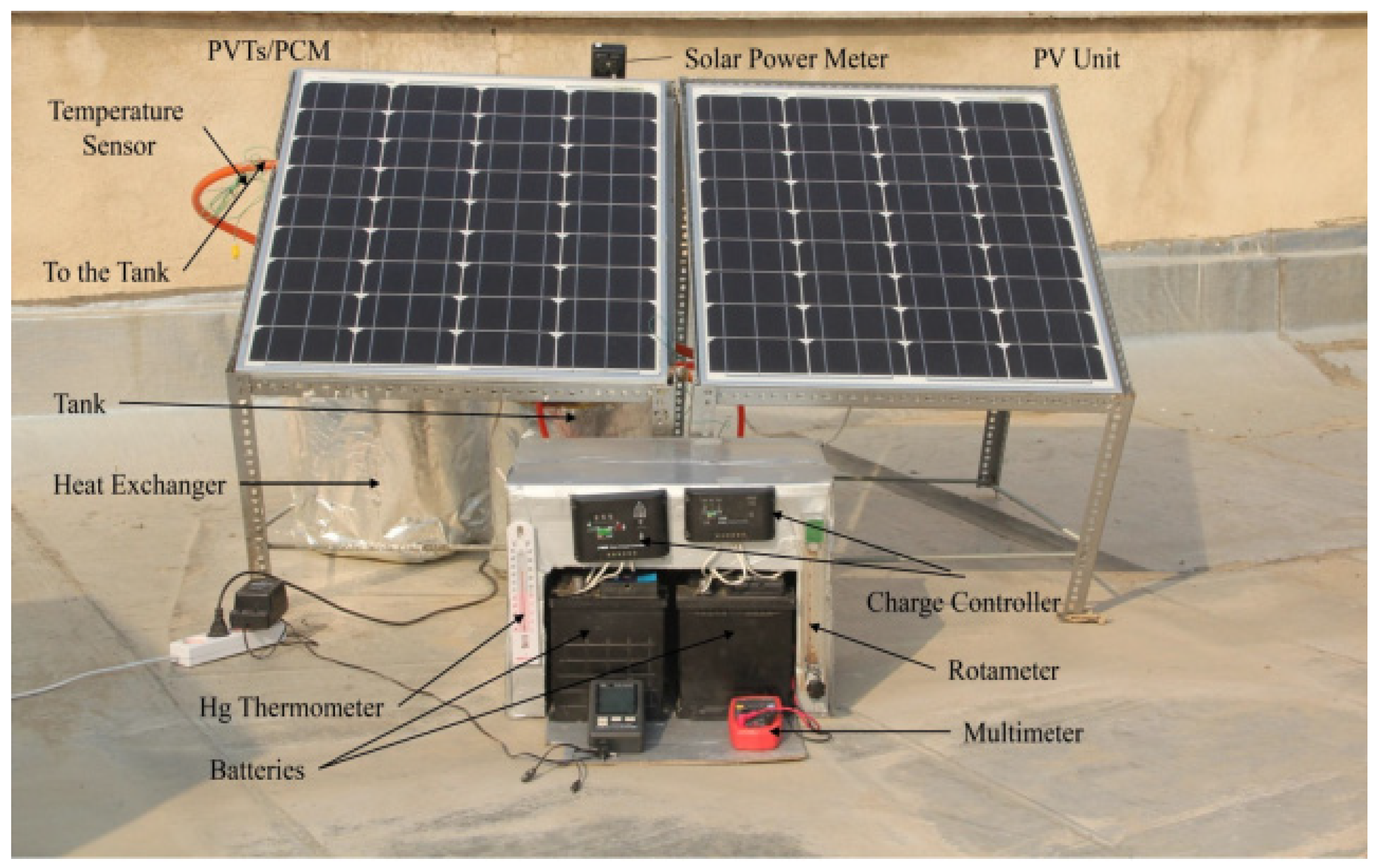
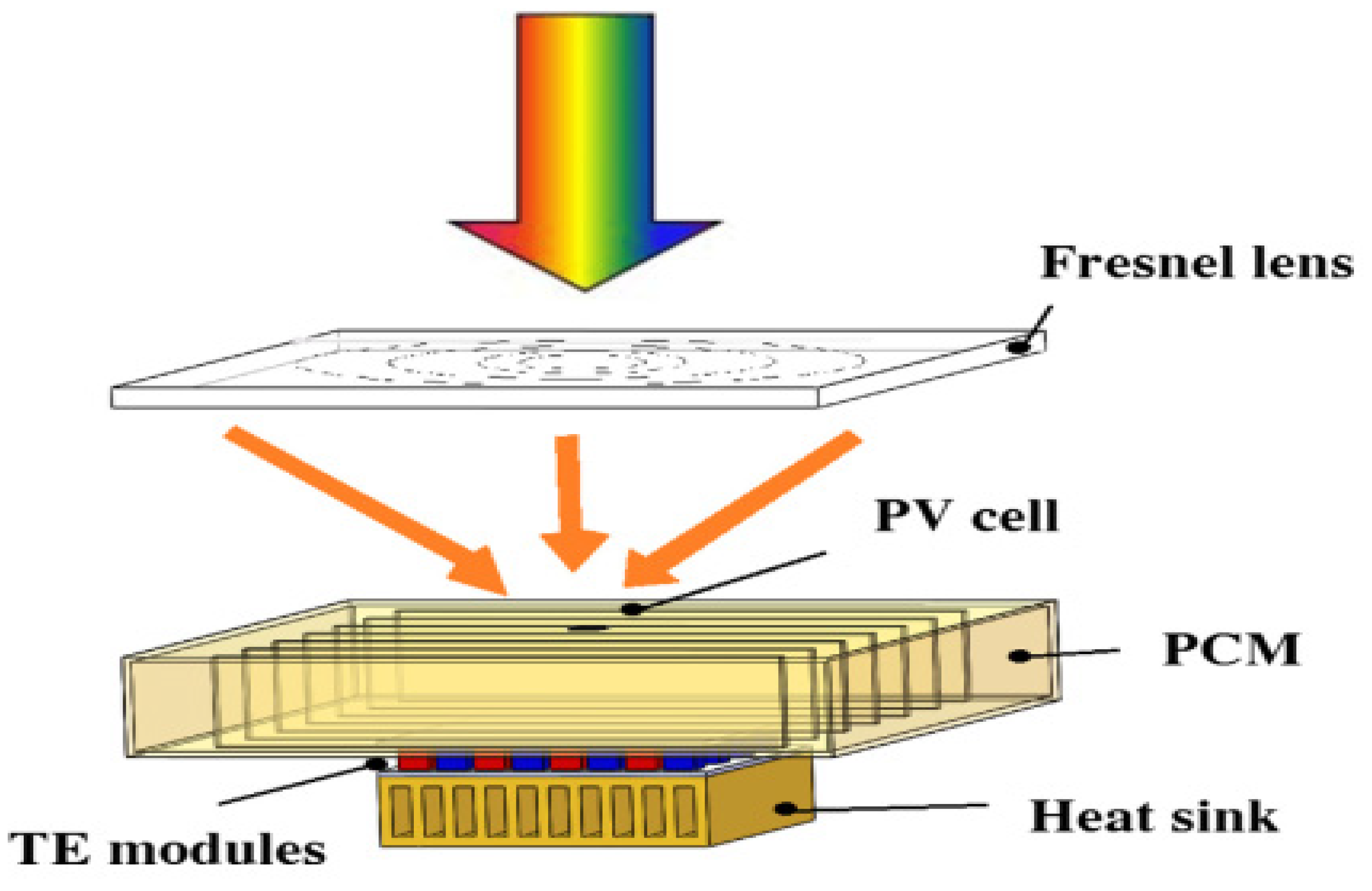
| Reference | Location | Parameter | Type of Study | Major Findings |
|---|---|---|---|---|
| G. Ménézo and G. Julien, 2017 [48] | Lyon, France | Fully wetted absorber PVT collector’s thermal and electrical performance | Numerical study | PCM integration in a water PVT absorber improved the execution of the system in terms of electrical and thermal parameters |
| Hachem et al., 2017 [49] | Lebanon | Photovoltaic cells using pure and combined PCMs | Experiments and transient energy balance | The electrical efficiency of the PV module was improved by an average of 3% when a pure PCM was used and by an average of 5.8% when a mixed PCM was used. |
| A. Hasan et al., 2017 [50] | United Arab Emirates | PV/PCM | Yearly energy performance | In hot weather conditions, the PV/PCM system raised the annual PV electrical energy yield by 5.9% |
| A. Hasan et al., 2014 [16] | China | PV/PCM | Energy and cost saving | At high temperatures and in high-solar radiation environments, PV/PCM systems were financially feasible. |
| Indartono et al., 2016 [51] | Indonesia | PV performance by using yellow petroleum jelly as PCM | Experimental study | Efficiency and power were increased. |
| Kazemian et al., 2019 [52] | China | PVT/PCM | Numerical investigation | The electrical and thermal energy efficiency of the PVT/PCM system increased as the thermal conductivity of the PCM increased. |
| Khanna et al., 2017 [53] | India | PV/PCM | Numerical study | As tilt angle increased from 0 to 90°, the PV efficiency increased from 18.1 to 19% by using the PCM, and efficiency was improved from 17.1 to 19% |
| Maatallah et al., 2019 [38] | Kottayam, India | PVT/PCM/water | Experimental study | The thermal efficiency, electrical efficiency, and overall efficiency improved by 26.87%, 17.33%, and 40.59%, respectively, as compared to those of the traditional PV panel. |
| Nouira and Sammouda, 2018 [15] | Tunisia | PV/PCM | Numerical study | Dust deposition density reduced electrical power. A rise in wind speed led to an increased heat loss. A wind azimuth angle increase caused an increase in the operating temperature of the PV module. |
| Preet et al., 2017 [35] | India | PVT system with and without PCM | Experimental investigation | Decreasing the PV panel’s temperature increased its output power, i.e., electrical yield, and improved the production of electricity. |
| Simón-Allué et al., 2019 [54] | Spain | PCM influence on different models of PVT collectors | Experimental study | Distribution of heat output improved, generating up to 30% of the full thermal power after sun exposure was removed. |
| Smith et al., 2014 [55] | United Kingdom | PV energy output enhanced by PCM cooling | Global analysis | Better results were seen, whereby an optimal PCM melting temperature was chosen for the place in question, and the PCM melted completely during the day. |
| Waqas et al., 2017 [56] | China | Thermal behavior of a PV panel integrated with PCM-filled metallic tubes | Experimental study | An efficiency increase of up to 3% was observed. The fin effect was observed to cool the PV panel, as the PV panel was kept at a lower temperature. |
| Yang et al., 2017 [13] | China | Comparison of PVT/PCM and PVT systems | Experimental investigation | Thermal efficiencies of the PVT and PVT/PCM systems were 58.35% 69.84%, respectively. Solar electrical efficiencies of the PVT and PVT/PCM systems were 6.98% and 8.16%, respectively. |
| Zhao et al., 2019 [17] | China | PVT/PCM | Year-round performance analysis | As compared to the reference PV system, 2.46% produced the largest year-round increase in electricity. The economic analysis revealed that the PV/PCM system might not be viable for actual use at this point without a substantial increase in PCM efficiency or the utilization of electricity-and-heat generation. |
| Browne et al., 2016 [47] | Ireland | PVT/PCM | Heat retention | PCM was seen to be an efficient way of retaining heat for later removal of heat. |
| Kazemian et al., 2020 [57] | Mashhad, Iran | Glazed and unglazed PVT system integrated with PCM | Experimental approach | The dual-use of glass cover and PCM in PVTs contributed to increased efficiencies. |
| Lin et al., 2021 [34] | Australia | Optimization of a solar PVT collector coupled with PCM thermal energy storage | Experimental investigation | The total system average efficiency rose from 37.6 to 40.2%, and the latent TES capacity average daily use ratio improved from 13.3 to 79.5%. |
| Malvi et al., 2011 [58] | United Kingdom | Combined photovoltaic solar–thermal system incorporating PCM | Energy balance | The PV output increased typically by 9%, with an average water temperature increase of 20 °C. |
| Qasim et al., 2020 [44] | Pakistan | Hybrid PCMs on thermal management of PV panels | Experimental study | 1-PCM configuration demonstrated improved performance only when 1-PCM configuration had lower-melting point PCM than those in 2-PCM configurations |
| Touati et al., 2017 [45] | France | Discharging from a multiple-PCM storage tank | Numerical study | The geometry of the fins reduced discharge time, as the staggered fins provided better performance than the in-line fins. |
| Xu et al., 2020 [42] | China | PVT/PCM | Experimental study | The findings showed that the use of the PCM in the solar collector greatly reduced PV panel temperature variations and increased the performance of the PV system. |
| Yuan et al., 2018 [46] | China | PVT/PCM | Numerical simulation and experimental study | The PVT with PCM and water-pipe-based PVT results for daily electrical efficiency were 12.1% and 11.9%, respectively; the thermal efficiencies of the two systems were 42.3% and 44.5%, respectively. |
| Bigaila and Athienitis, 2017 [59] | Canada | PVT air collector assisting a façade-integrated, small-scale heat pump with radiant PCM panel | Numerical study | As compared to the entire air system, drops in energy consumption of 14.5% and in heating power of 11.3% were achieved. |
| Lin and Ma, 2016 [60] | Australia | Taguchi–Fibonacci search method | Experimental study | The coefficient of thermal efficiency enhancement of the house increased from 45.54 to 72.22% relative to the results without optimization. |
| Reference | Location | Parameter | Type of Study | Major Findings |
|---|---|---|---|---|
| Al-Waeli et al., 2017 [61] | Selangor, Malaysia. | Nanofluid- and nano-PCM-based PVT | experimental study | Increased the open circuit voltage from 11–13 to 20–21 V, the power rose from 61.1 to 120.7 W, the electrical efficiency rose from 7.1 to 13.7%, and thermal efficiency reached 72%. |
| Eisapour et al., 2020 [20] | PVT systems using microencapsulated PCM nanoslurry coolant | Exergy and energy analysis | Higher performance energy and energy efficiencies due to higher thermic conductivity and heat capacity were found. | |
| Ho et al., 2016 [6,26] | Taiwan | PV integrated with double water-saturated MEPCM layers | Numerical simulation | The thermal and electrical efficiency of the MEPCM/PV module greatly improved. |
| Naghdbishi et al., 2020 [62] | Iran | MWCNT/water-based PVT/PCM | Experimental investigation | The thermal and electrical efficiencies increased up to 23.58% and 4.21%, respectively, as compared to pure water as coolant fluid. |
| Qiu et al., 2016 [65] | China | MPCM slurry-based PVT system | Experimental investigation | (1) Increasing the amount of slurry Reynolds resulted in improved solar thermal and electrical efficiencies, an increased drop in pressure, and decreased module temperature, and (2) increasing the concentration of MPCM resulted in decreased module temperature and an increased drop in pressure. |
| Abdelrazik, Saidur, and Al-Sulaiman, 2020 [66] | Saudi Arabia | PVT/PCM system using different combinations of nanoenhanced PCM | Thermal regulation | Increasing the loading of nanoparticles in a PCM provided better cooling and improved overall performance. |
| Sardarabadi et al., 2017 [63] | Iran | ZnO/water nanofluid and PCM in PVT systems | Experimental study | The simultaneous use of both a nanofluid and a PCM for the cooling system, based on the results of an exergy analysis, improved the system average exergy performance by more than 23% relative to that of a traditional PV module. |
| Tanuwijava et al., 2013 [67] | Taiwan | Thermal management performance of MEPCM modules for PV applications | Numerical Investigation | The microencapsulated PCM layer aspect ratio had important effects on the characteristics of heat transfer and overall thermal efficiency. |
| Reference | Location | Parameter | Type of Study | Major Findings |
|---|---|---|---|---|
| Al Imam et al., 2016 [41] | Bangladesh | Compound parabolic concentrator and PCM in a PVT solar collector | Experimental study | The overall efficiency of PVT was between 55% and 63% for a clear day, the thermal efficiency ranged from 40% to 50% for a clear day. |
| Cui et al., 2016 [88] | China | Concentrating photovoltaic–thermoelectric system with PCM | Theoretical work | The findings revealed that the PV/PCM/TE system’s efficiency was superior to those of single-PV panel and PV/TE systems. |
| Cui et al., 2017 [89] | China | A concentrated photovoltaic- thermoelectric system with PCM | Experimental investigation | Such a hybrid system had promising potential for the full-spectrum use of solar power. |
| Emam et al., 2017 [76] | Egypt | Inclined CPV/PCM system | Study and analysis | The angle of inclination of CPV/PCM system had a notable impact on the time taken to reach the full melting state, the transient difference of the mean cell temperature, and the uniformity of the PV local temperature. |
| Tabet Aoul et al., 2018 [19] | United Arab Emirate | CPV/PCM/T system with FPC | Experimental study | While the CPV/PCM/T generated less net energy (1527 kWh/m2.day) than the FPC (1803 kWh/m2-day), the production cost was 28% lower than that of the FPCC. |
| Reference | Location | Parameter | Type of Study | Major Findings |
|---|---|---|---|---|
| Huang et al., 2004 [92] | Ireland | BIPV using PCM | Experimentally validated numerical model | The temperature moderation achieved will lead to considerable changes in the operating performance of photovoltaic facades. |
| A. Hasan et al., 2016 [91] | United Arab Emirates | In a hot environment, a PV/PCM device improving building energy efficiency | Experimental study | There was a 7.2% rise in PV power production at peak and 5% on average, along with an increase in indoor cooling effect of 9.5% at peak and 7% on daytime average. |
| A. Hasan et al., 2010 [90] | Ireland | PCM for improving the thermal control of a building-integrated PV | Experimental study | For 30 min, a mean temperature reduction of 18 °C was reached, while a temperature drop of 10 °C was sustained for 5 h at 1000 W/m2 insolation. |
| Bigaila and Athienitis, 2017 [59] | Canada | PVT air collector assisting a façade-integrated, small-scale heat pump with radiant PCM panel | Numerical study | Compared to the entire air system, drops in energy consumption of 14.5% and in heating power of 11.3% were achieved. |
| Huang et al., 2006 [93] | United Kingdom | PCM in BIPV | Experimental evaluation | PCM was shown to be an effective means of minimizing temperature rise in PV systems. |
Publisher’s Note: MDPI stays neutral with regard to jurisdictional claims in published maps and institutional affiliations. |
© 2022 by the authors. Licensee MDPI, Basel, Switzerland. This article is an open access article distributed under the terms and conditions of the Creative Commons Attribution (CC BY) license (https://creativecommons.org/licenses/by/4.0/).
Share and Cite
Awad, M.M.; Ahmed, O.K.; Ali, O.M.; Alwan, N.T.; Yaqoob, S.J.; Nayyar, A.; Abouhawwash, M.; Alrasheedi, A.F. Photovoltaic Thermal Collectors Integrated with Phase Change Materials: A Comprehensive Analysis. Electronics 2022, 11, 337. https://doi.org/10.3390/electronics11030337
Awad MM, Ahmed OK, Ali OM, Alwan NT, Yaqoob SJ, Nayyar A, Abouhawwash M, Alrasheedi AF. Photovoltaic Thermal Collectors Integrated with Phase Change Materials: A Comprehensive Analysis. Electronics. 2022; 11(3):337. https://doi.org/10.3390/electronics11030337
Chicago/Turabian StyleAwad, Muthanna Mohammed, Omer Khalil Ahmed, Obed Majeed Ali, Naseer T. Alwan, Salam J. Yaqoob, Anand Nayyar, Mohamed Abouhawwash, and Adel Fahad Alrasheedi. 2022. "Photovoltaic Thermal Collectors Integrated with Phase Change Materials: A Comprehensive Analysis" Electronics 11, no. 3: 337. https://doi.org/10.3390/electronics11030337
APA StyleAwad, M. M., Ahmed, O. K., Ali, O. M., Alwan, N. T., Yaqoob, S. J., Nayyar, A., Abouhawwash, M., & Alrasheedi, A. F. (2022). Photovoltaic Thermal Collectors Integrated with Phase Change Materials: A Comprehensive Analysis. Electronics, 11(3), 337. https://doi.org/10.3390/electronics11030337









